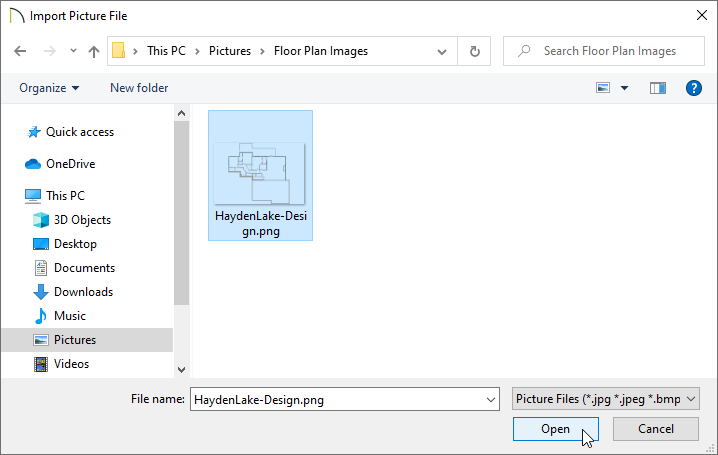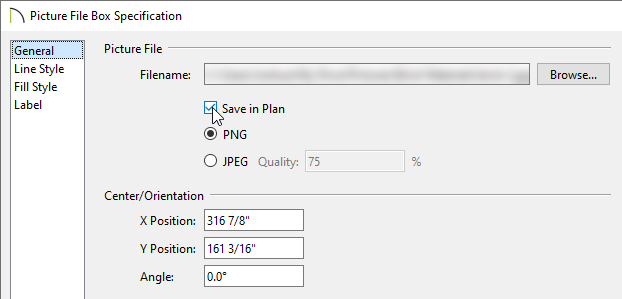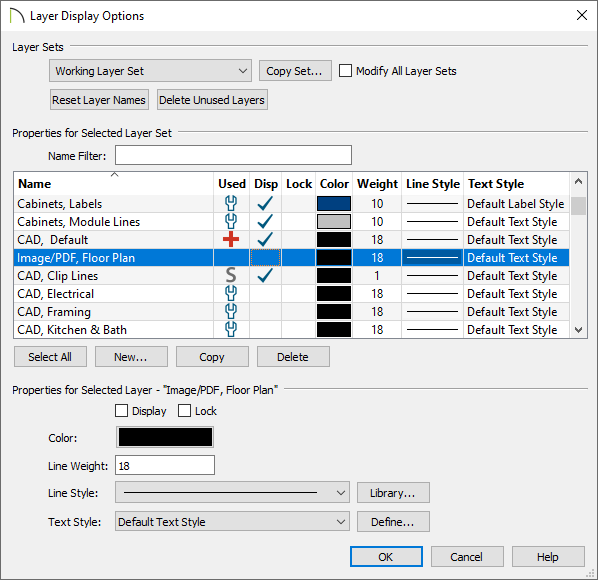Importing, Resizing, and Tracing Over an Image or PDF of a Floor Plan
QUESTION
My picture has dimensions on it and I would like to import it into Chief Architect to use it to create a 1:1 scale drawing. How do I do this?
ANSWER
There isn't a way to convert a digital image into a 3D model in Chief Architect; however, you can use an image of a floor plan, or a PDF, as a template to trace over. In many cases, imported images and PDFs are not scaled, so in order to produce an accurate model, you will need to make some adjustments to your drawing.
-
Importing an image or PDF
-
Saving an imported image or PDF
-
Resizing and tracing over an image or PDF
- Hiding or removing an image or PDF in X15 and newer
- Hiding or removing an image or PDF in X14 and prior
To import an image or PDF
- In your desired plan, navigate to File> Import> Import Picture
 or File> Import> Import PDF
or File> Import> Import PDF  .
.
- In the Import Picture File or Import PDF File dialog, browse to the location of the file on your computer, select it, then click Open.
Note: It is recommended to keep this file, as well as any other related files that are imported, in the same folder as your plan file. This is especially important when you use the Backup Entire Plan/Layout tool to create a project backup for transfer to another system. Please see the Related Articles section to learn more about this tool.

- If you have selected an image to be imported, the image will now appear in the center of your design.
If you have selected a PDF to be imported, an additional dialog will appear asking what pages you would like to import. Choose your desired page settings, then click OK. The page(s) will now appear in the center of your design.
Note: When an image or PDF is imported, it will be in the Back Drawing Group allowing you the ability to draw on top of it using the Chief Architect tools.
You can change the Drawing Group of an imported image or PDF by first selecting the imported file, and then selecting the View Drawing Order Edit Tools edit button on the Edit Toolbar.
To save an image or PDF
When you import an image or PDF, you are referencing a file on your computer and not actually saving it in your plan or layout. This means that if the image or PDF file were to be moved or deleted from your computer, you would no longer be able to see the image or PDF without relinking the file.
Instead of relying on the link to the image or PDF, you are able to instead save the image or PDF. However, do keep in mind that this may increase the overall file size of your projects.
- Use Select Objects
 to select the image or PDF and click the Open Object
to select the image or PDF and click the Open Object edit button.
edit button.
- On the General panel of the Picture File Box or PDF Box Specification dialog, select the Save in Plan box to keep the image saved within the file, then click OK.

To resize and trace over the image/PDF
- First, locate two walls or other objects in the image or PDF that you imported, in which you know the exact size of in the X and Y axes, then make a note of their length.
- Using the Select Objects
 tool, select the image or PDF, then click the Point to Point Resize
tool, select the image or PDF, then click the Point to Point Resize  edit button.
edit button.
- Choose two points on the image between which you know the distance. Click the first point (A) and then click the second point (B).
- In the Point to Point Resize dialog that opens next, type in the distance between the two points you selected in Step 3, ensure that the Retain Aspect Ratio box is checked, then click OK.

- You are now ready to utilize the various Wall
 , Window
, Window  , and Door
, and Door  tools to trace over the existing image or PDF.
tools to trace over the existing image or PDF.
For best results, use dimensions to accurately size and position all of the walls after you are finished tracing over the file.
To hide or remove an image or PDF in X15 and newer
- When you are finished, you can select the imported image or PDF and Delete
 it, or you can hide the layer that the image or PDF is on by continuing to the next step.
it, or you can hide the layer that the image or PDF is on by continuing to the next step.
- To hide the layer the image or PDF is on, simply hide the "Picture/PDF Boxes" layer:
- Navigate to Tools> Layer Settings> Display Options
 or access the Active Layer Display Options
or access the Active Layer Display Options  side window.
side window.
- Locate the "Picture/PDF Boxes" layer, then remove the check from the Disp column or Display checkbox.
- Navigate to Tools> Layer Settings> Display Options
To hide or remove an image or PDF in X14 and prior
- When you are finished, you can select the imported image or PDF and Delete
 it, or you can hide the layer that the image or PDF is on.
it, or you can hide the layer that the image or PDF is on.
- The image or PDF will come in on the "CAD, Default" layer, so it's recommended to create a custom* layer.
*Creating custom layers is only available in Chief Architect Interiors and Chief Architect Premier.
- Use Select Objects
 to select the image or PDF and click the Open Object
to select the image or PDF and click the Open Object edit button.
edit button.
- On the Line Style panel, note that the selected file is located on the "CAD, Default" layer. Click the Define button to the right of the Layer drop-down list.
- In the Layer Display Options dialog that displays:

- Click the Copy button in the middle of the dialog box.
- Give the new layer a short, descriptive name such as "Image/PDF, Floor Plan".
- Remove the check from the Disp column for this layer if you want to hide the image or PDF from view.
- Click OK and notice that your new layer will be selected in the Picture File Box or PDF Box Specification dialog.
- Click OK to close this dialog as well.
- Click the Copy button in the middle of the dialog box.
By adding fixtures, furniture and walls over the picture you will create a duplicate of the original floor plan image, and will be able to see your creation in a 3D camera view.
In this manner,your image or PDF can be used as a guide or template while creating a floor plan, and a drawing scaled at 1:1 can be produced using your Chief Architect software.


